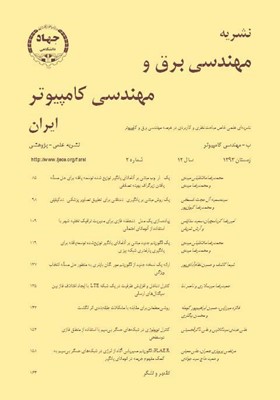PLAER: الگوريتم مسيريابي آگاه از انرژي در شبکههاي حسگر بيسيم به کمک مفهوم جريمه در اتوماتاي يادگير
محورهای موضوعی : مهندسی برق و کامپیوتر
مرتضي پرويزي عمران
1
,
علي معيني
2
,
حميد حاج سيدجوادي
3
![]()
1 - دانشگاه تهران
2 - دانشگاه تهران
3 - دانشگاه شاهد
کلید واژه: اتوماتاي يادگير شبکههاي حسگر بيسيم کاهش مصرف انرژی مسيريابي آگاه از انرژي,
چکیده مقاله :
حسگرهاي موجود در شبکههاي حسگر بيسيم معمولاً با انرژي باتري و با عمر محدود کار ميکنند، به همين دليل کاهش مصرف انرژي در آنها از اهميت بسزايي برخوردار است. در اين مقاله، الگوريتم مسيريابي جديدي جهت کاهش مصرف انرژي در اين شبکهها معرفي ميشود که از اتوماتاي يادگير به منظور يافتن مسير مناسب جهت ارسال بستههاي داده بهره ميگيرد. رويکرد اصلي اين الگوريتم به اين صورت است که مصرف انرژي در مسيرهاي مختلف را با در نظر گرفتن سطح انرژي و تأخير گرهها متوازن نگه ميدارد و بدين منظور از شيوه جريمهدهي در اتوماتاي يادگير بهره ميگيرد. براي ارزيابي کارايي الگوريتم پيشنهادي، اين پروتکل مسيريابي با نرمافزار OMNET++ شبيهسازي و نتايج به دست آمده با دو پروتکل LABER و BEAR مقايسه شده است. نتايج شبيهسازي نشان ميدهد که در شبکه با ساختار استاتيک، در مصرف انرژي و ارسال بستههاي کنترلي و در نتيجه طول عمر شبکه در پروتکل پيشنهادي نسبت به پروتکلهاي مقايسهشده بهبود حاصل شده است.
Sensors in WSN work with batteries that have limited energy capacity. Therefore, reduction in power consumption is a very important issue. In this paper, we present a new routing algorithm to reduce power consumption in wireless sensor networks. This algorithm deploys Learning automata in each node to find a suitable path for routing data packets. In order to aim this goal the algorithm uses penalty based approach in learning automata and considers energy level of nodes and latency of packet delivery as well. Performance of our new developed algorithm has been compared with LABER and BEAR protocols in OMNET++ simulator. Simulation results show that, in a network with static nodes, energy consumption and control packets reduce significantly and network lifetime increases in comparison with two other protocols.
[1] J. Yick, B. Mukherjee, and D. Ghosal, "Wireless sensor network survey," Computer Networks, vol. 52, no. 12, pp. 2292-2330, Apr. 2008.
[2] G. Anastasi, M. Conti, M. Di Francesco, and A. Passarella, "Energy conservation in wireless sensor networks: a survey," Ad Hoc Networks, vol. 7, no. 3, pp. 537-568, May 2009.
[3] K. S. Narendra and M. A. L. Thathachar, "Learning automata - a survey," Systems, Man and Cybernetics, IEEE Trans. on, vol. 4, no. 4, pp. 323-334, Jul. 1974.
[4] M. Ankit, M. Arpit, T. J Deepak, R. Venkateswarlu, and D. Janakiram, "TinyLap: a scalable learning automata-based energy aware routing protocol for sensor networks," Communicated to IEEE Wireless and Communications and Networking Conf., Las Vegas, NV, USA. 2006.
[5] S. M. Abolhasani, M. R. Meybodi, and M. Esnaashari, "LABER: a learning automata based energy - aware routing protocol for sensor networks," in Proc. of the Third Information and Knowledge Technology, IKT'07, 9 pp., Mashad, Iran, 27-29 Nov. 2007.
[6] A. H. Fathy Navid and H. Haj Seyed Javadi, "ICLEAR: energy aware routing protocol for WSN using irregular cellular learning automata," in Proc. IEEE Symp. on Industrial Electronics and Applications, ISIEA'09, vol. 1, pp. 463-468, 4-6 Oct. 2009.
[7] E. Ahvar and M. Fathy, "BEAR: a balanced energy - aware routing protocol for wireless sensor networks," Wireless Sensor Network, vol. 2, no. 10, pp. 793-800, 2010.
[8] J. A. Torkestani, "Backbone formation in wireless sensor networks," Sensors and Actuators A: Physical, vol. 185, pp. 117-126, Oct. 2012.
[9] M. A. L. Thathachar and P. S. Sastry, "Varieties of learning automata: an overview," Systems, Man, and Cybernetics, Part B: Cybernetics, IEEE Trans. on, vol. 32, no. 6, pp. 711-722, 2002.
[10] A. Varga, "The OMNeT++ discrete event simulation system," in Proc. of the European Simulation Multiconference, ESM'01, pp. 319-324, Prague, Czech Republic, Jun. 2001.
[11] L. F. W. van Hoesel and P. Havinga, "A lightweight medium access protocol (LMAC) for wireless sensor networks: reducing preamble transmissions and transceiver state switches," 2004.


